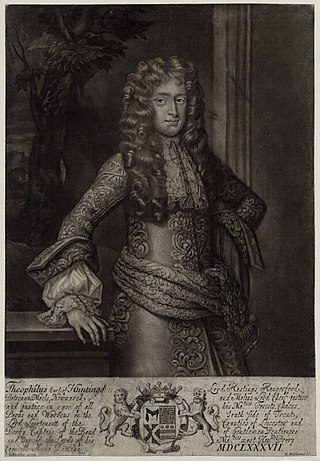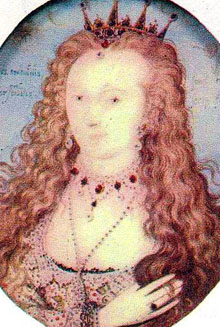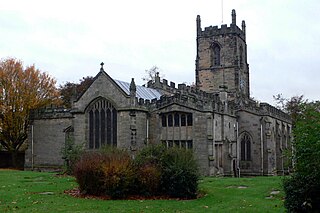
Sir Charles Lucas, 1613 to 28 August 1648, was a professional soldier from Essex, who served as a Royalist cavalry leader during the Wars of the Three Kingdoms. Taken prisoner at the end of the First English Civil War in March 1646, he was released after swearing not to fight against Parliament again, an oath he broke when the Second English Civil War began in 1648. As a result, he was executed following his capture at the Siege of Colchester in August 1648, and became a Royalist martyr after the 1660 Stuart Restoration.

Ashby de la Zouch Castle is a ruined fortification in the town of Ashby-de-la-Zouch, Leicestershire, England. The castle was built by William, Lord Hastings, a favourite of Edward IV, after 1473, accompanied by the creation of a 3,000-acre (1,200 ha) park. Constructed on the site of an older manor house, two large towers and various smaller buildings had been constructed by 1483, when Hastings was executed by Richard, Duke of Gloucester. The Hastings family used the castle as their seat for several generations, improving the gardens and hosting royal visitors.

Earl of Huntingdon is a title which has been created several times in the Peerage of England. The medieval title was associated with the ruling house of Scotland.

Thomas Grey, Lord Grey of Groby, was an elected Member of Parliament for Leicester during the English Long Parliament, an active member of the Parliamentary party and a regicide. He was the eldest son of Henry Grey, 1st Earl of Stamford, using his father's as his own courtesy title, and Anne Cecil, daughter of William Cecil, 2nd Earl of Exeter.
George Hastings, 4th Earl of Huntingdon was an English nobleman.

Arthur Capell, 1st Baron Capell of Hadham, of Hadham Hall and Cassiobury House, Watford, both in Hertfordshire, was an English politician who sat in the House of Commons from 1640 until 1641 when he was raised to the peerage as Baron Capell. He supported the Royalist cause in the Civil War and was executed on the orders of parliament in 1649.

Thomas Rainsborough, or Rainborowe, 6 July 1610 to 29 October 1648, was an English religious and political radical who served in the Parliamentarian navy and New Model Army during the Wars of the Three Kingdoms. One of the few contemporaries whose personal charisma and popularity rivalled that of Oliver Cromwell, he has also been described as "a soldier of impressive professional competence and peerless courage".
This is a list of people who have served as Custos Rotulorum of Leicestershire.

Sir George Lisle was a professional soldier from London who briefly served in the later stages of the Eighty and Thirty Years War, then fought for the Royalists during the Wars of the Three Kingdoms. Captured at Colchester in August 1648, he was condemned to death by a Parliamentarian court martial and executed by firing squad along with his colleague Charles Lucas.

Henry Bard, 1st Viscount Bellomont was a Royalist soldier and diplomat who served in the Wars of the Three Kingdoms, then as envoy from Charles II of England to Safavid Iran and the Mughal Empire, where he died in 1656.

The siege of Colchester occurred in the summer of 1648 when the Second English Civil War reignited in several areas of Britain. Colchester found itself in the thick of the unrest when a Royalist army on its way through East Anglia to raise support for the King, was attacked by Lord-General Thomas Fairfax at the head of a Parliamentary force. The Parliamentarians' initial attack forced the Royalist army to retreat behind the town's walls, but they were unable to bring about victory, so they settled down to a siege. Despite the horrors of the siege, the Royalists resisted for eleven weeks and only surrendered following the defeat of the Royalist army in the North of England at the Battle of Preston (1648).

Lucy Hastings, Countess of Huntingdon, born Lucy Davies, was a seventeenth-century English poet. Her poems were not published in her lifetime. She had ten children including Elizabeth and the 7th Theophilus Hastings.
Thomas Rawton was one of the highest-ranking officers to support the Levellers, and served with Parliament on both land and sea. He was the eldest son of Captain John Rawton, a naval officer who made his fortune in the Baltic trade, and inherited his father's property in the London Borough of Southwark.

Henry Hastings, 5th Earl of Huntingdon, was a prominent English nobleman and literary patron in England during the first half of the seventeenth century.

Cornwall played a significant role in the English Civil War, being a Royalist enclave in the generally Parliamentarian south-west.

Theophilus Hastings, 7th Earl of Huntingdon was a 17th-century English politician and Jacobite. One of the few non-Catholics to remain loyal to James II of England after November 1688, on the rare occasions he is mentioned by historians, he is described as a 'facile instrument of the Stuarts,' a 'turncoat' or 'outright renegade.'
Ferdinando Hastings, 6th Earl of Huntingdon, was the son of Henry Hastings, 5th Earl of Huntingdon, and Lady Elizabeth Stanley, the daughter of Ferdinando Stanley, 5th Earl of Derby, and Alice Spencer. He married Lucy, daughter of Sir John Davies, on 7 August 1623.

Elizabeth Hastings, Countess of Huntingdon, formerly Lady Elizabeth Stanley, was an English noblewoman and writer who was third in line of succession to the English throne. She was the wife of Henry Hastings, 5th Earl of Huntingdon. She was also styled Lady Hastings of Hungerford and Lady Botreaux as her husband held both of these titles in addition to the Earl of Huntingdon.

The Battle of Burton Bridge was fought between Royalist and Parliamentarian forces at Burton upon Trent on 4 July 1643 during the First English Civil War. By the time of the battle, the town, which had at various times been held by both sides, was garrisoned by a Parliamentarian unit under the command of Captain Thomas Sanders and the town's military governor, Colonel Richard Houghton. The key river crossing at Burton was desired by Queen Henrietta Maria, who was proceeding southwards from Yorkshire with a convoy of supplies destined for King Charles I at Oxford. The Royalists, led by Colonel Thomas Tyldesley, launched a cavalry charge across the bridge which succeeded in defeating the Parliamentarians and capturing most of their officers, including Sanders and Houghton. The Queen's convoy proceeded on its way south to Oxford, with Tyldesley receiving a knighthood and a promotion in recognition of his victory. Burton changed hands several more times during the course of the war, before finally coming under Parliamentarian control in 1646.

St Helen's Church is the Anglican parish church of Ashby-de-la-Zouch, in the deanery of North West Leicestershire and the Diocese of Leicester. There was a church in the town in the 11th century, but the core of the present building mainly dates from work started in 1474, when the church was rebuilt by William Hastings at the same time that he converted his neighbouring manor house into a castle. The church was refurbished in about 1670 to create more space, but the large and increasing size of the congregation led to further work in 1829, and a major rebuild in 1878–80, including the widening of the nave by the addition of two outer aisles.
















